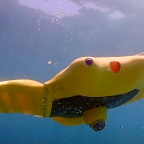
Scientists have found a striking similarity in the DNA that enables some bats and dolphins to echolocate.
A key gene that gives their ears the ability to detect high-frequency sound has undergone the exact same changes over time in both creatures.
The researchers report their findings in the journal Current Biology.
It may be the first time that identical genetics has been shown to underpin the evolution of similar characteristics in very different organisms.
Nature is full of cases where the path taken by evolution has resulted in the same traits, or phenotypes, developing independently in diverse animal groups.
Examples would include the tusks displayed by elephants and walruses, or the bioluminescence seen in fireflies and jellyfish.
“It’s common on a morphological scale but it’s assumed not to occur at a DNA level because there are so many different ways to arrive at the same solution,” explained Dr Stephen Rossiter of Queen Mary’s School of Biological and Chemical Sciences.
“The fact that we’re able to link convergence of the DNA with a phenotype I think is unique, and in such a complex phenotype as hearing as well,” he told BBC News.
Animal and human
Many bats and toothed whales like dolphins have exceptional hearing, and are able to track down their prey by emitting high-frequency noises and then listening for the echoes that bounce back.
Critical to echolocation are tiny hairs in the inner ear that move in response to sound.
Their keen performance is driven by a particular protein known as prestin, which in turn is encoded by a gene, also known as prestin.
Two studies published this week in Current Biology find that this gene in bats and dolphins has picked up the same mutations over time.
“We’ve found a whole suite of amino acid changes that are common to these two groups that have evolved in parallel, convergently,” Dr Rossiter said.
Both research teams also have evidence showing that these changes to prestin were selected for, suggesting that they must be critical for the animals’ echolocation for reasons the researchers do not yet fully understand.
“The results imply that there are very limited ways, if not only one way, for a mammal to hear high-frequency sounds,” said Professor Jianzhi Zhang of the University of Michigan, US, who led the other study.
This type of research is a beneficiary of the immense and ongoing effort to understand human genetics, which finds interesting targets for biologists from many fields to follow up.
Mutations in the prestin gene in humans have been shown to be associated with the loss of high-frequency hearing. It was this revelation that initiated the study of prestin’s role in echolocation.
Source: http://news.bbc.co.uk/1/hi/sci/tech/8478566.stm












Social Profiles